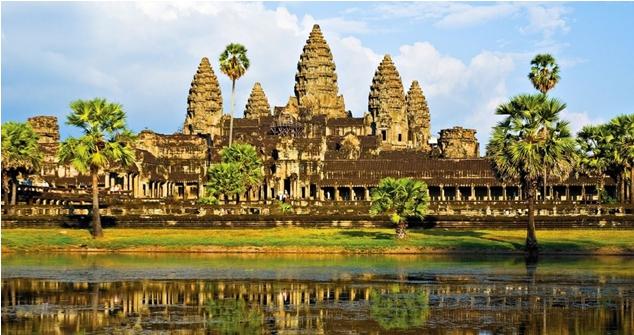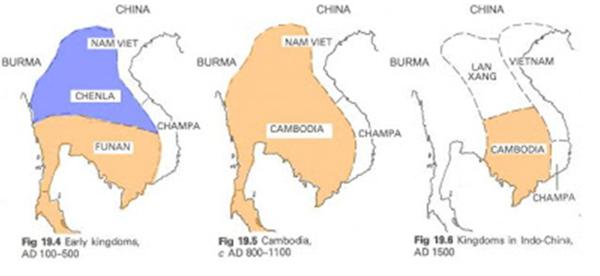
The History of the Kings of Angkor
Before the spread of the Angkorian civilization, Southeast Asia resembled more of a commercial crossroads, extending from the Mediterranean to China. Indian and Chinese traders began arriving in the region in greater numbers, exposing the indigenous peoples to their cultures. However, it was Indian culture that took root.
Indian culture, including its religion (Hinduism and Buddhism), law, political theory, science, and writing, spread throughout the region over several centuries and was gradually adopted by the existing states.

Pre-Angkor: Funan and Chenla
During the pre-Angkorian period, Cambodia was made up of several princely states, often limited to fortified cities, which fought each other to expand their territories. Two dominant powers existed in the region: The Indian state of Funan, centered in southern Vietnam and Cambodia, and the state of Chenla in northern Cambodia.
From the 6th century, as Funan began to decline, Chenla and the Mon people conquered Funan’s territory, marking the beginning of the pre-Angkorian period. The third and final king of a unified Chenla, Isanavarman I, constructed the pre-Angkorian temples of Sambor Prei Kuk near the modern city of Kampong Thom. If traveling from Phnom Penh to Siem Reap by road, you will pass through Kampong Thom, where it is possible to take a detour to visit these pre-Angkorian ruins.
Under the successor of Isanavarman I, Chenla disintegrated into small warring states. It was briefly unified under Jayavarman I in the mid-7th century, only to collapse again after his death. According to traditional accounts, Chenla eventually split into two rival states or alliances: "Land Chenla" in northern Cambodia/southern Laos and "Water Chenla" centered further south in Kampong Thom.

The beginning of the Angkorian Era
Jayavarman II, a former Khmer prince and warrior, is considered the first king of the Angkorian era. Around 790, after a long stay at the royal court in Java, he returned to Cambodia to unify the states. After numerous battles and alliances, in 802, he declared a sovereign and unified "Kambuja" under a single ruler. He legitimized his "universal kingship" by establishing a royal cult, the cult of the god-king, during his declaration on Mount Kulen north of Siem Reap. From then on, the king was considered the earthly representative of Shiva, the supreme god of the Brahmanic trinity (Brahma, Shiva, Vishnu), and was thus worshiped as a deity.
Jayavarman II then continued to pacify rebellious areas and expand his kingdom. He settled in Roluos, which became the first capital and was named Hariharalaya in honor of the combined god of Shiva and Vishnu. He ruled from Hariharalaya until his death in 850.
Thirty years after his death, King Indravarman III built the Preah Ko temple, the first significant monument in the "Roluos Group," in honor of Jayavarman II. He also constructed the first large Baray (water reservoir), establishing the permanent marks of Angkorian royalty: in addition to the cult of the king, temple construction and major water projects became a royal tradition.
Indravarman III’s son, Yasovarman I, continued his father's tradition by building the Eastern Baray, the final large temple of the Roluos Group, Lolei, and the first major temple in the Angkor region, Phnom Bakheng. After a violent confrontation with his brother over the throne, Yasovarman I moved the capital in 893 from the burned Roluos Palace to the newly established Yasodharapura at Angkor. Except for one brief exception, the capital would remain in the Angkor region for the next 500 years.

The peak of the Khmer Empire
A period of territorial, political, and commercial expansion followed the return to Angkor. The royal court constructed several important monuments, including Ta Keo, Banteay Srei, Baphuon, and the Western Baray. The kings of this era demonstrated military strength, with King Rajendravarman, for example, leading successful campaigns against the eastern enemy, Champa, in the mid-10th century.
After nine years of political turmoil, King Suryavarman I took control of the kingdom in 1010. He led the Khmers to numerous important military victories, including the conquest of the Mon Empire to the west, capturing much of modern Thailand and thus reuniting the western part of old Funan under Khmer control. A century later, King Suryavarman II led several successful campaigns against the traditional eastern enemy of the Khmers, Champa, in central and southern Vietnam.
By the early 12th century, under Suryavarman II, the empire was at its peak politically and territorially. At its height, Suryavarman II oversaw the construction of the most spectacular architectural monument in Angkor, Angkor Wat, as well as other monuments such as Thommanon, Banteay Samre, and Beng Melea. Angkor Wat was built as the state temple of Suryavarman II and possibly as his funerary temple. Moreover, vast battle scenes from his campaigns against Champa are depicted in the magnificent bas-reliefs on the south wall of Angkor Wat.
Towards the end of the 12th century, internal conflicts, rebellious states in the provinces, and unsuccessful campaigns against the Vietnamese weakened the empire. In 1165, during a turbulent period in which Khmer and Cham princes conspired and fought together and against each other, a usurper named Tribhuvanadityavarman seized power in Angkor.
In 1177, the usurper was killed in one of the worst defeats the Khmers suffered at the hands of the Chams. Champa, allied with some Khmer factions, launched a naval attack on Angkor, followed by a land assault. The city was attacked, burned, and occupied by the Cham people.

Jayavarman VII: The Legendary King
The Chams controlled Angkor for four years until the legendary Jayavarman VII launched a series of counterattacks over several years. After the Cham defeat in 1181, Jayavarman VII was declared king. Breaking with nearly 400 years of tradition, he made Mahayana Buddhism the state religion and initiated grand projects to build Angkor's monuments.
Jayavarman VII’s construction campaign took place at a frenetic pace, with hundreds of monuments being constructed in less than 40 years. His works include the famous stone faces of Bayon, his capital of Angkor Thom, the temples of Ta Prohm, Banteay Kdei, and Preah Khan, among many others. Jayavarman VII also led an aggressive military campaign against Champa. In 1190, he captured the Cham king and brought him to Angkor. He annexed all of Champa, thus expanding the Khmer Empire into southern Vietnam.
The prodigious building campaign of Jayavarman VII also marked the end of the Khmer Empire, as no other major monuments were constructed after his death in 1220. His successor, Indravarman II, continued some of Jayavarman VII’s monument projects with limited success.

The end of an era
Although monument construction ceased, the capital remained active for many years. Hinduism made a return under Jayavarman VIII at the end of the 13th century, during which most of the Buddhist monuments of Angkor were systematically defaced. Thousands of Buddha images were removed, and some were crudely altered into Hindu lingas and bodhisattvas. Examples of this can still be seen at the temples of Ta Prohm and Preah Khan.
Jayavarman VIII also built the final Brahmanic monument in Angkor, the small East Prasat Top tower at Angkor Thom. After Jayavarman VIII's death, Buddhism returned to Cambodia, but in a different form. Instead of Mahayana Buddhism, Theravada Buddhism took root and remains the dominant religion in Cambodia to this day.
Subsequently, Angkor suffered repeated invasions by the Thais from the west. After a 14-month siege of Angkor in 1431, King Ponhea Yat moved the capital from Angkor to Phnom Penh in 1432, primarily to facilitate trade due to its proximity to the Mekong River. After this move, the capital shifted several times, first to Lovek, then to Oudong, before settling permanently in Phnom Penh in 1866.
Although the history of the Khmer civilization cannot be reduced solely to the Angkorian period, and Angkor does not solely embody the richness, diversity, and grandeur of Khmer art, it was these monuments that fascinated Westerners when they discovered the mysterious capital buried beneath vegetation in 1860. Henri Mouhot's book Travels in Siam, Cambodia, Laos and Annam played a significant role in bringing worldwide attention to this part of the world and spurred the arrival of the first tourists.
